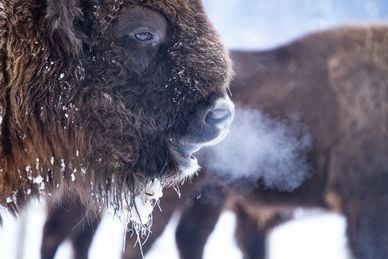About Bison
Name & types

Bison are scientifically named Bison bison, but also called American Bison, American buffalo or just buffalo.
There are two sub-species of bison in North America: the Plains Bison (B. b. bison) and Woods Bison (B. b. athabascae), although there is a very small difference in genetic makeup.
Woods typically live at higher latitudes, have a darker coat, weigh a little more, have a hump that is further up their bodies above the shoulders, and are taller and skinnier.
Build (conformation)

Bison cows average five feet tall at the hump and weigh around 1,000 pounds. Bison bulls stand more than six feet tall at the hump and can weigh well over 2,000 pounds. Bulls’ heads are twice the size as cows, measured across the forehead, and their horns are drastically thicker and larger.
Both bulls (males) and cows (females) grow a single set of horns, if they break a horn, a new one will not replace the lost horn, but they will still continue to grow.
Reproduction
-15.jpg/:/rs=w:388,h:194,cg:true,m/cr=w:388,h:194)
Cows can begin to breed at the age of two, with the calf gestation period being nine months, and their first calf being born when they are becoming three years old. Cows bread once a year and go through a rut. The rut begins around the beginning of July and ends towards the end of September. Calves are born from the middle of April until the end of May. Bison are naturally fertile and can have a calf every year with their reproductive life lasting their whole lives. Cows are very protective mothers and often form bonds with other mothers to help fight off predators to protect the young.
Calves
-88.jpg/:/cr=t:0%25,l:0%25,w:100%25,h:100%25/rs=w:388,cg:true)
Calves are born at 35 to 50 pounds with no hump and very tiny horns. Initially calves have a red coat but will turn brown after a couple months. Calves can stand and walk very soon after birth and soon can run as fast as the herd. They nurse for about 7 months before being weaned but begin eating grass one month after birth. Calves can constantly be seen playing with the other calves of the herd.
Impact on the ecosystem
Bison are considered a keystone species in that they provide a great benefit to the ecosystem. As they roam, their split hooves help to aerate the soil, loosening compacted soil, driving seeds into the ground, and creating small depressions in the soil to allow water to accumulate to further help plant life or allow rodents and insects to drink the water. Their grazing helps to spread speeds as well as distribute nutrients to the ground through their manure. As bison shed their thick winter coats, their hair is used as nesting material for birds and rodents.
Behavior
-19.jpg/:/cr=t:0%25,l:0%25,w:100%25,h:100%25/rs=w:388,cg:true)
Although they look slow, bison can reach speeds over 25 miles per hour, jump over six feet high, and are considered excellent swimmers.
Bison have a relaxed temperament unless they are threatened. Bison will graze for a couple hours and can then be seen laying down and relaxing while they “chew their cud”. This is part of their total digestive system that allows them to consume fibrous forage and extract the nutrients in it.
While they are chewing their cud, they are also resting. They do not sleep like humans, but instead rest periodically throughout the day, sort of “dozing” off and on. They do sleep a few hours every couple days and will lay flat out on the ground when they do so, unlike other ungulates.
Though bison bulls do fight for dominance during the rut, they very rarely fight to the death.
Bison are herd animals, but the bulls typically stray away from the herd until mating season; the cows stay together to protect the other cows and calves (babies).
Bison are very intelligent animals. Many habits have been witnessed, such as:
- laying down at the beginning of a snowstorm, then standing up once it stops snowing and grazing the patch of snow-free grass that was underneath
- facing into the wind, allowing the wind to aerodynamically pass around their bodies
- wallowing, or rolling around in mud and dusty areas to keep cool and to fight off bugs
This website uses cookies.
We use cookies to analyze website traffic and optimize your website experience. By accepting our use of cookies, your data will be aggregated with all other user data.